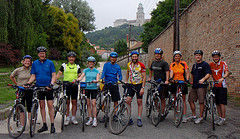 Many travelers these days are taking bike tour vacations as a healthier, slower way to savor a new region or foreign country.
Many travelers these days are taking bike tour vacations as a healthier, slower way to savor a new region or foreign country.
Many bike tour companies have started up to deliver all kinds of cycling vacation options, from family-friendly tours to tours for special interests like local wine, food, art and more.
Just like any other trip, it’s important to put a little thought into your personal safety on a bike tour vacation, so we’ve researched the tips essential to enjoying a safe bike tour.
1. Have the right bike for your tour
This one really isn’t a secret. Every rider knows that the right bike can make all the difference on a cycling trip. Get a bike that’s too heavy, and you’ll tire easily. Get one that’s too light, and it won’t handle an unpaved trail. Either way, you’re on vacation and you’ll want it to go as smoothly as possible.
Your best bet is to spend some time riding on the types of road surfaces you’ll encounter on your vacation before you leave. This will help you learn what works and what doesn’t. Many riders bring their own bikes on their bike tours because they are more familiar with them.
Hint: Bicycles are often covered with travel insurance baggage coverage (up to the covered limit) when your bike is checked with the airline, so you may not need extra coverage unless your bike is expensive.
2. Have the right protective gear
A good helmet is the most widely recommended safety gear, and wearing it is required in some regions, but gloves, a wind- and water-proof jacket, and sunglasses also help keep a rider safe and comfortable. Lots of biking-specific clothing has reflective features so you are more easily seen in low light.
Just like any sport, cycling comes with a range of specialized gear that can make your vacation more comfortable and more safe.
3. Pack a repair kit – and know how to use it
The more reliable and full-service bike tour companies will have a lead rider or a repair service that will repair your bike when things go wrong, but if you are going solo you’ll need a minimal repair kit.
Of course, what goes in that kit will just be dead weight if you don’t know how to use it, however, so take what you need to do the repairs you know how to manage.
4. Know the local biking rules
Different countries have different rules of the road for driving, cycling, and walking, so it’s important to familiarize yourself with those rules. In France, for example, it’s a legal requirement for riders to wear yellow reflective vests when cycling after dark.
If you’re riding with a good tour company, they will have a list of rules you can review and memorize. If not, a good guidebook can provide this information.
5. Pack a map – and keep it dry
On most bicycling tours, the rider will be given or have brought with them a map, but pulling out the map in the rain or touching it with sweaty hands can make it hard to read. Keeping your map dry is essential, so consider putting it in a plastic zipper bag you can see through.
This one trick alone could save you from a much longer ride than you expected should you get lost.
6. Stay well hydrated and nourished
You’ll be working hard and burning lots of calories and sweating, so it’s critical to have plenty of water and a little food with you each day of your cycling vacation.
If you’re riding a rented bike, ask the rental company if it comes with water bottles. If not, consider bringing a light-weight backpack with a water pouch. You can find these at any sports equipment store.
7. Avoid a sunburn
Even when you’re cycling under cloud cover, your skin is exposed to the sun’s rays. Sunscreen is key to keeping your skin protected and avoiding a sunburn. Put it on before you start and have a small container of sunscreen to re-apply during the day. Your helmet and clothing will provide some protection too.
8. Be prepared for a medical emergency
Depending on your health insurance coverage and where you are taking your cycling tour, you’ll want to be prepared for accidents, illnesses, and dental emergencies that may occur on your trip. Most bike tour companies will have you sign a waiver to limit their liability, so you’ll need to have your own coverage.
See our Adventure Travel Insurance tutorial for the information you need to help you choose a travel insurance plan for your cycling vacation.
